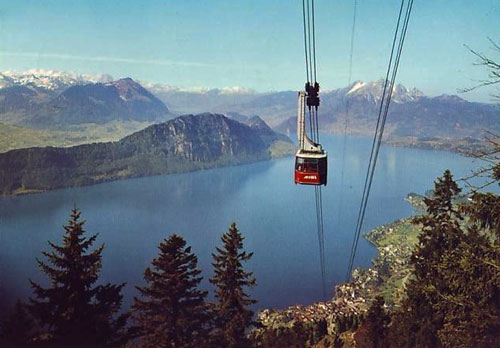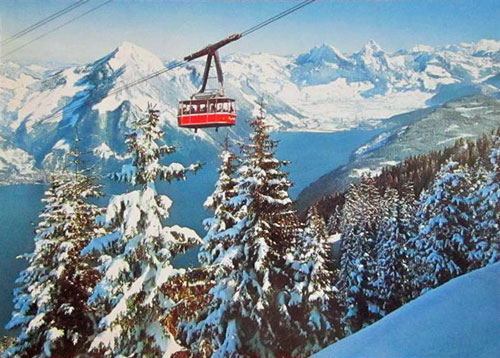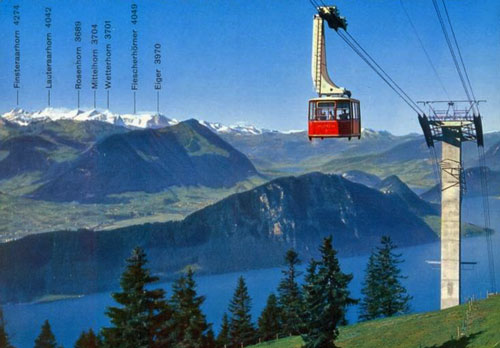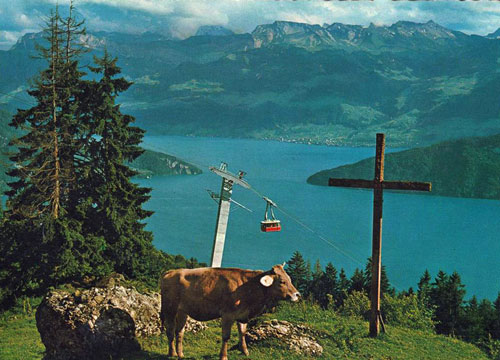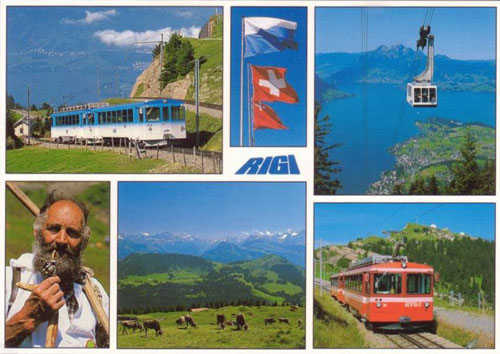|
|
|
| |
Vitznau-Rigi Bahn - Arth-Rigi Bahn
- Luftseilbahn Weggis-Rigi Kaltbad
 All images link to larger
copies which will open in a new window/tab
All images link to larger
copies which will open in a new window/tab
|
|
|
This page shows postcards and images of the rack railways and
cable cars on Rigi, located between two of the arms of Lake
Luzern, in Switzerland.
Rigi-Bahnen AG is a group of railways on Rigi, including two
standard gauge rack railways, the Vitznau-Rigi Bahn (VRB) and
the Arth-Rigi Bahn (ARB), along with the Luftseilbahn
Weggis-Rigi Kaltbad (LWRK) cable car.
Reaching a height of 1,752 metres above sea level, the
Rigi-Bahnen are the highest standard gauge railways in Europe.
They are also the highest railways in both cantons of Luzern
and Schwyz. The Vitznau-Rigi Bahn is also notable as the first
mountain rack railway in Europe, and only the second in the
world, after the Mount Washington Cog Railway in the United
States.
A third railway, the Rigi-Scheiddegg Bahn was never electrified,
and closed in 1931. It survives as a panoramic footpath.
In 1992 the
Arth-Rigi-Bahn (ARB) in Arth and the Rigibahn in Vitznau,
formally the Vitznau-Rigi-Bahn (VRB), and the Luftseilbahn
Weggis-Rigi Kaltbad (LWRK) combined to create Rigi Bahnen AG.
(Ref: Wikipedia)
|
|
|
|
|
|
| |
|
|
Swiss Railways
Platform 5
European Handbook No.5 by Haydock, Fox, Garvin
Lokomotiven & Triebwagen der Schweizer Bahnen
Band 2: Privatbahnen Westschweiz & Wallis by Peter
Willen (Orell Fuessli Verlag)
http://www..com
h
h
|
|
|
|
|
Vitznau-Rigi Bahn - Arth-Rigi Bahn
- Luftseilbahn Weggis-Rigi Kaltbad
 All images link to larger
copies which will open in a new window/tab
All images link to larger
copies which will open in a new window/tab
Vitznau-Rigi Bahn
(RB/VRB)
Aware of the scenic location of
Mount Rigi, Swiss engineer Niklaus Riggenbach masterminded the construction
of a railway from Vitznau, on the shores of Lake Luzern and the southern
flank of Mount Rigi, to a point close to its summit. He already had the
technology as he had patented, in France in 1863, a system of toothed racks
set between the railway tracks interlocking with cogwheels fitted under the
locomotives.
Jointly, with fellow engineers Olivier Zschokke and
Adolf Naef, he submitted an application to the canton of Luzern for
permission to build a line from Vitznau to Rigi Staffelhöhe, a point
somewhat below the summit of Rigi, but the nearest point to the summit
within that canton. The cantonal administration already knew of the success
of the Mount Washington Railway and saw the advantages in this construction,
granting permission on 9 June 1869.
The construction itself began in the following
September, the limited liability company, which had offered 1250 shares was
greatly over-subscribed on the first day of issue. On 21 May 1870,
Riggenbach’s birthday, locomotive No.1, named Stadt Luzern, made its first
trial run. Exactly one year later the first mountain railway using rack and
pinion technology was officially opened, Riggenbach, never noted for missing
an opportunity, drove the first train to the upper terminus at Rigi
Staffelhöhe.
The line, from Vitznau to Rigi Staffelhöhe was 5 km
(3.1 mi) long and climbed a total of 1,115 m (3,658 ft) to reach a height of
1,550 m (5,085 ft) at its summit, the maximum gradient being 1 in 4 (25%).
(Ref: Wikipedia)
(Ref: Wikipedia)
The Rigibahn used Riggenbach rack system. The first
steam locomotives had vertical boilers, considered as the best solution for
the steep gradients of the track. The locomotives could push either two
small coaches or one large one.
The first three 1870/1871 locomotives were delivered by the Niklaus
Riggenbach railway workshops in Olten. The locomotives were named Stadt
Luzern, Stadt Basel and Stadt Bern and they were
numbered 1-3. In 1872 three more locomotives (4-6) were delivered without
names. Since traffic continued to increase, four more locos (7-10) were
delivered in 1873, this time built by SLM.
The vertical boiler and firebox certainly had its advantages, but access was
difficult for inspection and cleaning. Between 1882-1892 Riggenbachs
Schnapsbrennereien, for 9000 to 10,000 SFr each, converted the locos to
conventional horizontal boilers. Locos 5 and 10 were later fitted with
superheaters. SLM built new locomotive No.11 in 1899 so that there was
always a loco in reserve - the peak August service requiring ten locos in
service. Due to further increases in traffic, similar No.12 was delivered in
1902.
In 1908 Arth-Rigi Bahn loco No.2 was acquired and renumbered 14. Final steam
loco deliveries were Nos.15-17 in 1913, 1923 and 1925. No.15 was withdrawn
in 1941 but Nos.16/17 survived and were restored for occasional use in
1969-71.
In 1937 SLM rebuilt No.7 back to its original state with vertical boiler and
luggage platform and in 1939, temporarily designated as RB No.1, it was
exhibited at the Swiss National Exhibition in Zurich. It then returned for
use as a monument to Vitznau. In 1959 it moved to the Museum of Transport in
Luzern. The remaining locomotives were withdrawn between 1913-1937.
For the 125th anniversary VRB No.7 was made operational and was used during
summer 1996 between Rigi Staffel and Rigi Kulm. In 1997 it returned for the
anniversary '150 years Swiss Railways' - again on the Rigi Bahnen, but this
time from Arth-Goldau. The elderly locomotive then returned to the Museum of
Transport at Luzern.
(Ref: www.swissrails.ch)
Postcard of restored VRB vertical boiler loco No.7 in
service
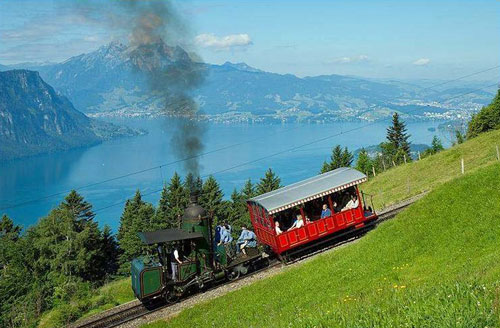
Postcard of restored VRB vertical boiler loco No.7
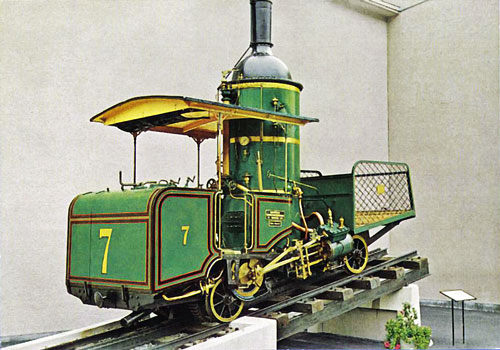
Postcard of restored VRB vertical boiler loco No.7
plinthed at Vitznau (on right)

Historic postcards of rebuilt and new VRB steam locos

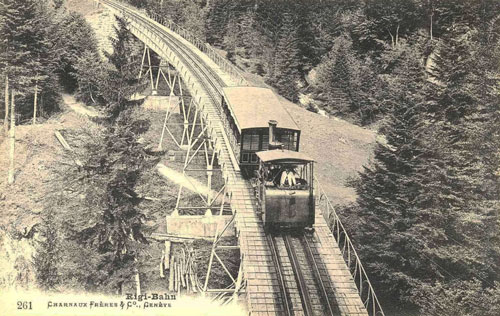
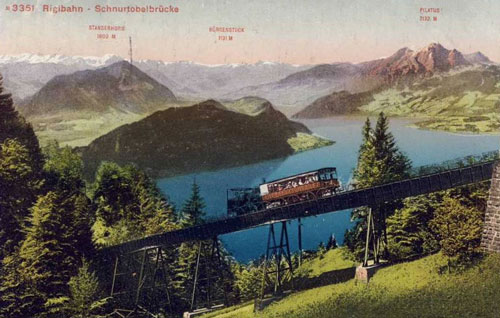
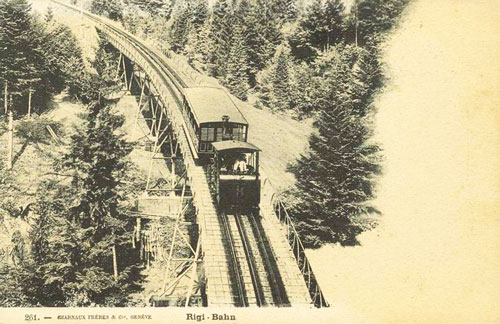
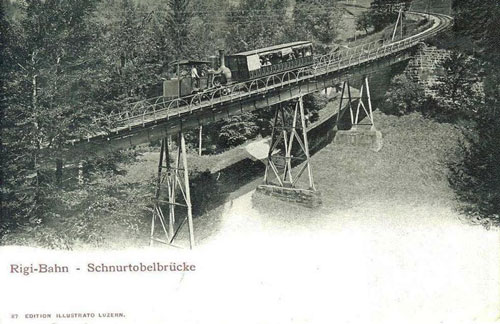
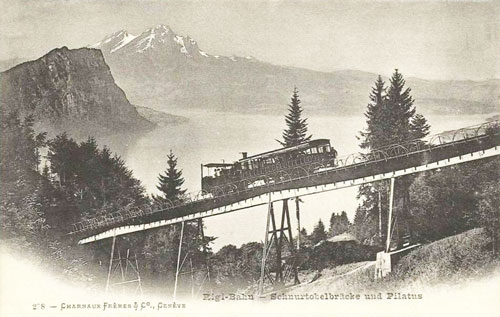
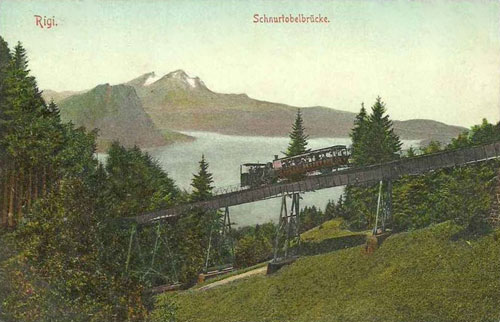
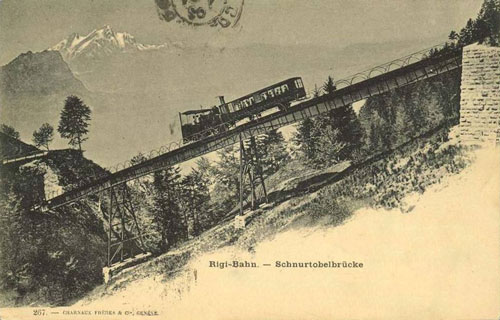
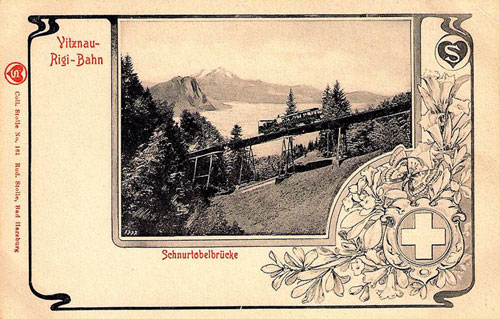
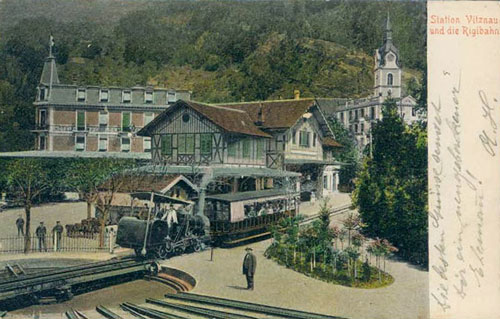
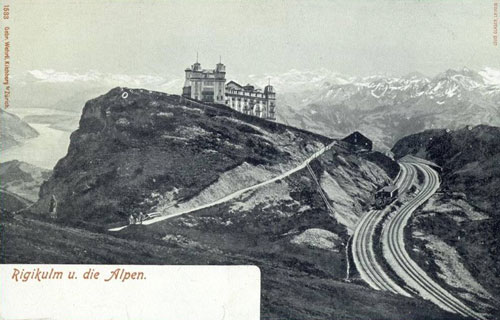
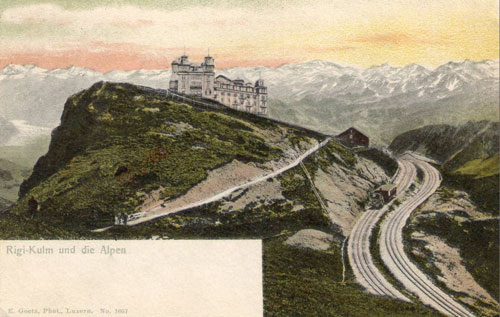
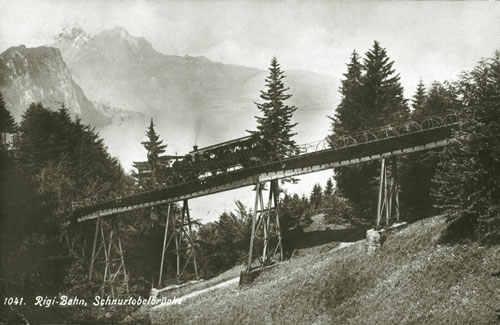
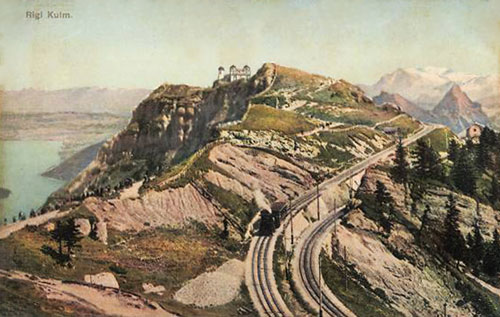
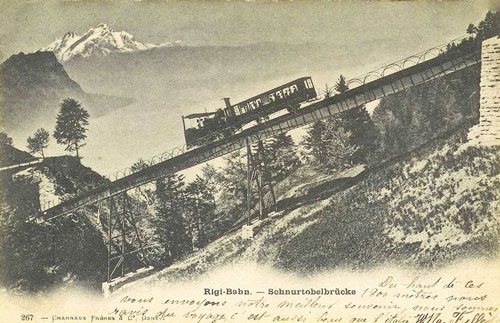
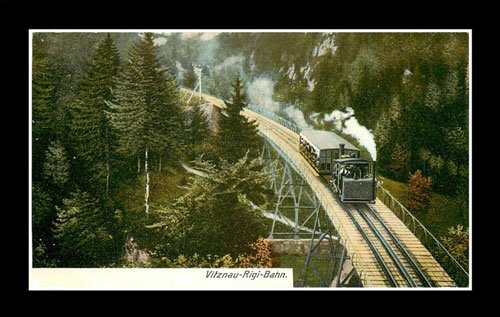



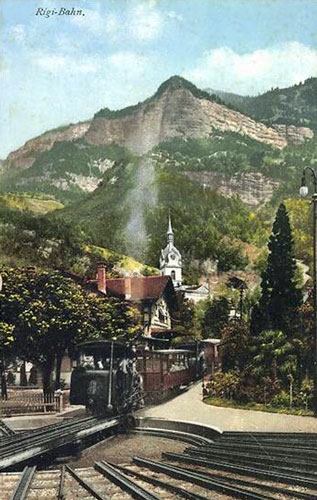
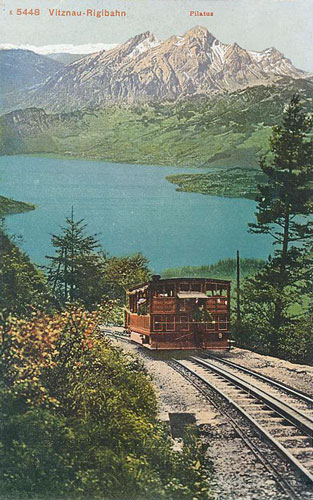
Postcard of restored VRB steam loco No.16 (centre)
Railcar No.5 is to the left and plinthed vertical boiler loco No.7 on the
right

Postcards of restored VRB steam loco No.17
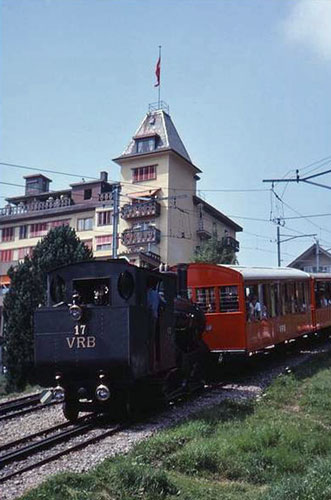
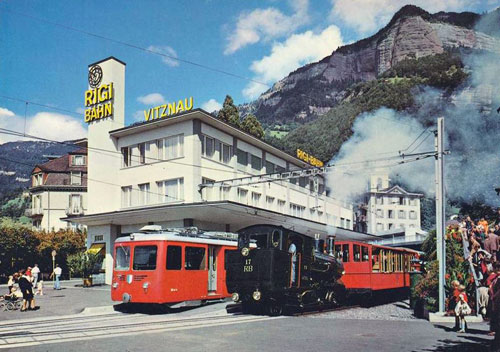
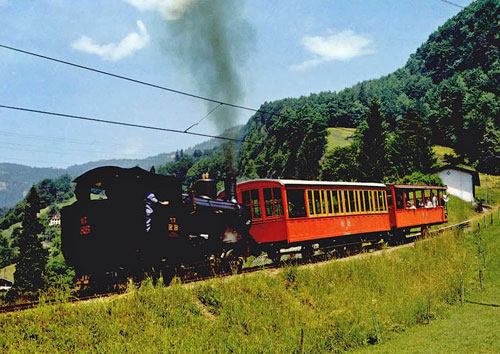
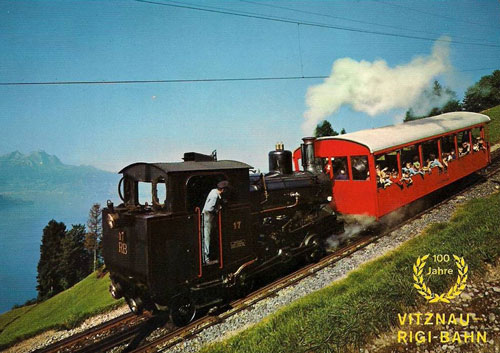
RB/VRB Electric Operation
The Arth-Rigi Bahn was the first of the Rigi-Bahnen
to be electrified, completed in 1929. Electrification of the Vitznau-Rigi
Bahn was completed in 1937 supplying 1500V DC through overhead wires.
VRB railcars numbered 1-3 were introduced with the electrification of the line in
1937 and were products of SLM/BBC. Designated class Bhe2/4, they are painted
in a red livery. A fourth railcar designated Ceh 2/4 arrived in 1953.
Following increases in traffic on the line a
further class BDhe4/4 No.5 from the same makers arrived in 1964 to a
slightly updated design.
In 1986, SLM/BBC supplied two railcars (BDhe2/4), numbered 21 and 22, plus
single-ended driving trailers (Bt) numbered 31 and 32. Although the railcars
are capable of working as single units they are normally to be found working
with the trailers.
A battery-powered shunter for use at Vitznau was purchased in 1982. Parts of
the former SBB loco Tm 540 (Raco, 1949) were incorporated in the design,
which was built by the company Raco and Stadler. The Ta 2/2 No.1 is a
battery tractor that has a speed of 5 km/h, and can pull a load of 35 tons.
(Ref: www.swissrails.ch)
Postcards of 1937 Bhe2/4 railcars No.1-5, pushing older
vehicles converted to control trailers
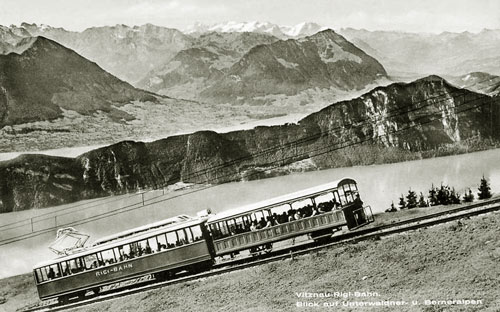
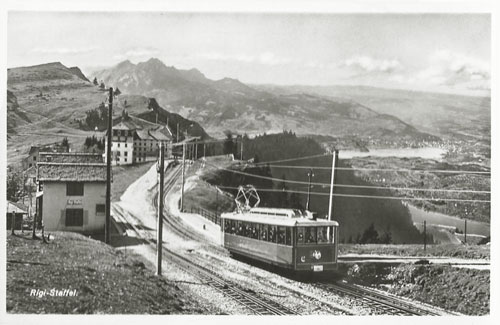
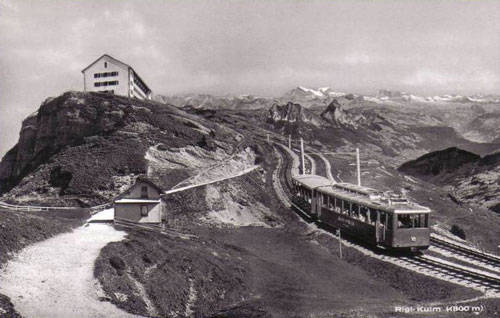
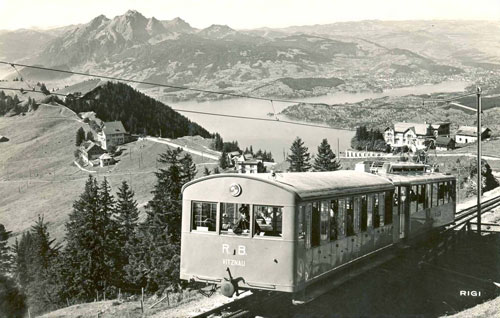
Postcard of 1937 VRB Bhe2/4 railcar No.1

Photo of Bhe2/4 1937 VRB railcar No.1
Photo: ©1985 Ian Boyle
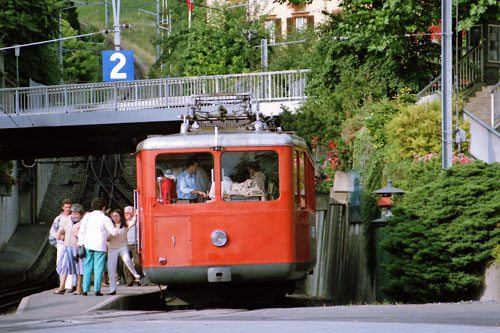
Postcard of 1937 Bhe2/4 railcar No.2
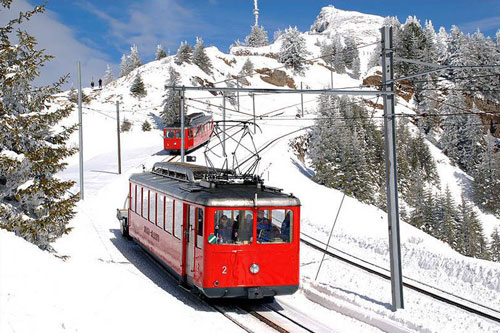
Photos of 1937 Bhe2/4 VRB railcar No.3
Photos: ©1985 Ian Boyle
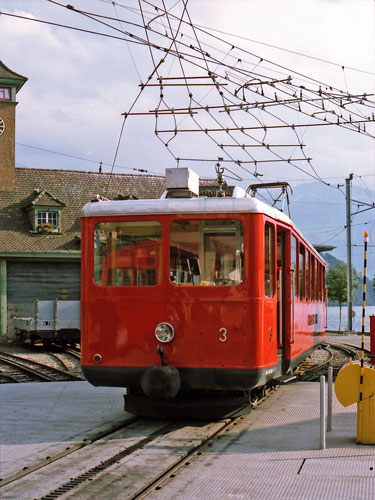
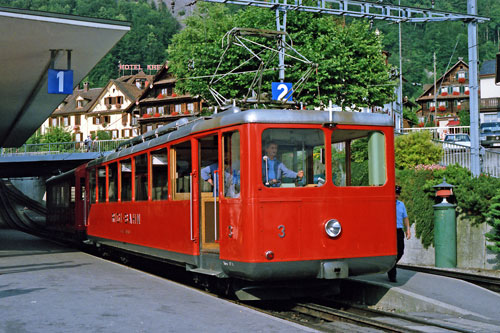
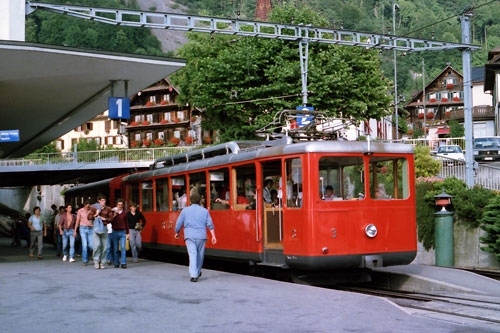
Postcards of 1937 VRB Bhe2/4 railcars No.3
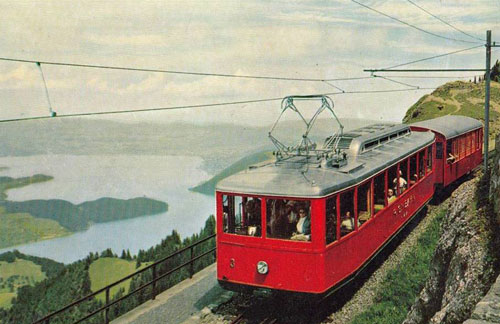
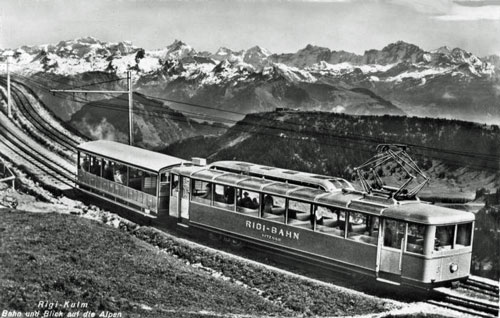
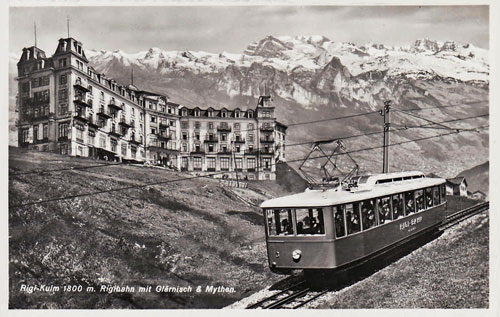
Postcard of 1964 VRB Bhe2/4 railcar No.5 (left)

Postcard of 1964 BDhe2/4 VRB railcar & trailer Nos.21+31
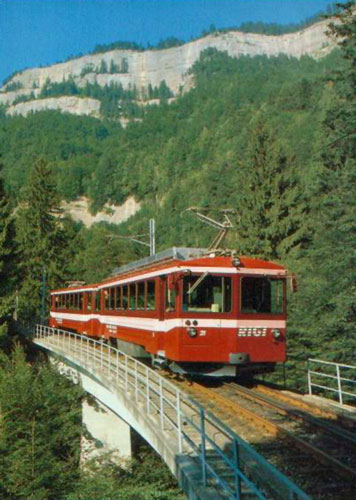

By the time construction
started on the Arth–Rigi Railway, construction had also started on the
Gotthard railway, the Swiss trans-alpine railway line from northern
Switzerland to the south and Italy. It was clear that this main line railway
would include a station in Arth, now known as Arth-Goldau station.
The concession to construct the Arth–Rigi Railway was
ceded, in 1873, to the International Company for Mountain Railways in Aarau,
a company founded by Riggenbach and this company carried out the railway
project as general contractor at a cost of CHF 4.2 million and also supplied
five of the six steam locomotives needed to operate it. Construction of the
first section, that from Arth-am-See, a station by Lake Zug, to Oberarth
commenced in 1873 and once the position of the railway station in had been
agreed with the main line company, in 1874, construction work on the second
section began, the Arth-Rigi Railway becoming operational on 4 June 1875.
The line offered only summertime services until 1884 when year-round
operation commenced.
The line from Arth to the junction at Rigi Staffelhöhe
was 6.8 km (4.2 mi) long, making the total length of the Arth line 8.6 km
(5.3 mi) The maximum gradient is 1 in 5 (20%).
The first electrification, on the short section of line from Arth to Goldau,
came with the commencement of the winter timetable in 1906. The mountain
section from Goldau to Rigi Kulm, only operated in the summer until 1928,
had the power switched on the following year, making this the first standard
gauge rack and pinion railway in the country to convert to electric
traction.
(Ref: Wikipedia)
The Arth-Rigi Bahn (ARB) ordered five locos for the
use on the railway from Aarau. Initially it was intended that these would be
vertical-boilered like those on the Vitznau-Rigi Bahn (VRB). The
accessibility and maintenance problems of the vertical boilers were by then
apparent and it was decided to change to design to incorporate conventional
loco boilers. The VRB locos were subsequently rebuilt with similar boilers.
Loco Nos.1-3 were used by the contractors during construction of the
railway. Nos.4-5 arrived shortly after the opening. No.4 was involved in a
accident in 1885 and was rebuilt as a dual rack and adhesion loco which
could be used as a shunter. Loco Nos. 1-5 were either sold or scrapped after
electrification.
A further loco (No.6) was delivered in 1899 from SLM. The performance of the
new locomotive was significantly better than in the older locos and when the
railway was electrified it was kept in reserve and used for works trains and
snow plough work. It was withdrawn in 1941 and scrapped in 1945, so no ARB
steam engines have been preserved.
(Ref: www.swissrails.ch)
Postcard of an ARB steam train
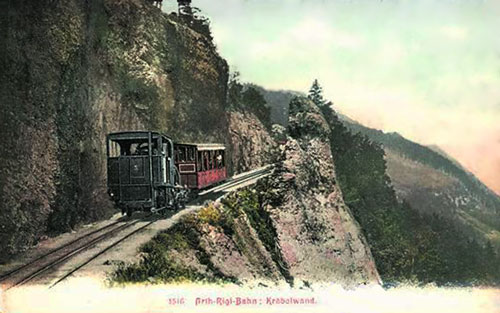
The Arth-Rigi Bahn was the first of the Rigi-Bahnen
to be electrified, initially from Arth to Goldau in 1907. Completion through
to Rigi Kulm was not until 1929. BDhe 2/4 railcars by Rastatt/Wüst and
numbered 3-5 were introduced with the electrification in 1907 (Nos. 1-2 were
shunters).
Railcar BDhe 2/4 No.6 was delivered by SWS/SLM/MFO in 1911. It was restored
in 1988. Similar No.7 arrived in 1929. Four more modern BDhe 2/4 railcars
11-14 were delivered by SLM/SAAS in 1949 (2x), 1954 and 1967. A more
powerful BDhe 4/4 railcar No.15 was bought from SLM/BBC in 1982.
(Ref: www.swissrails.ch)
Postcards of original ARB electric railcars
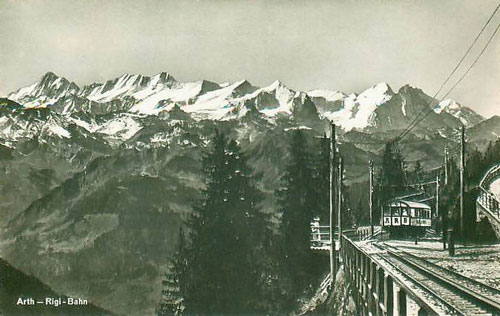
Postcards of ARB electric railcar BDhe 2/4 No.6
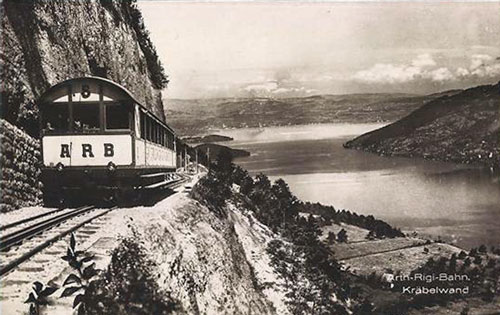
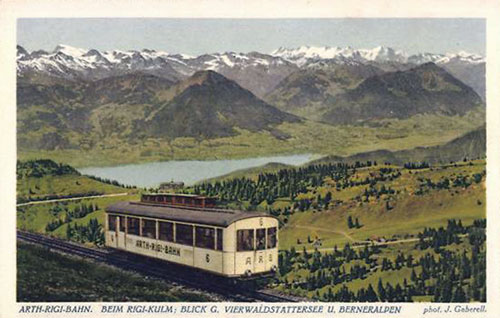
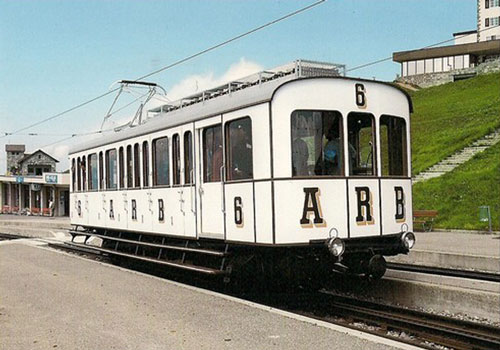
Postcards of original ARB electric railcar No.7
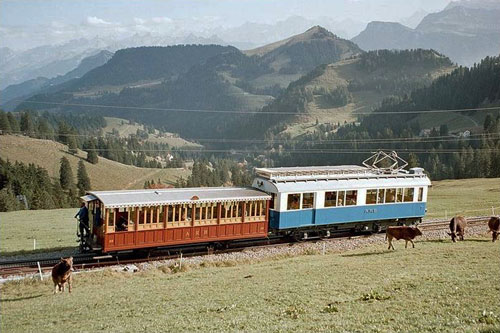
Postcards of original ARB 1954 electric railcar BDhe
2/4 No.12
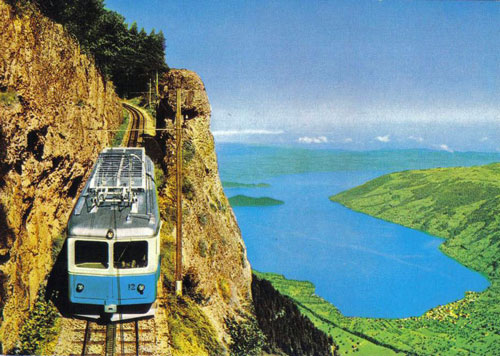
Postcards of original ARB 1954 electric railcar BDhe
2/4 No.12
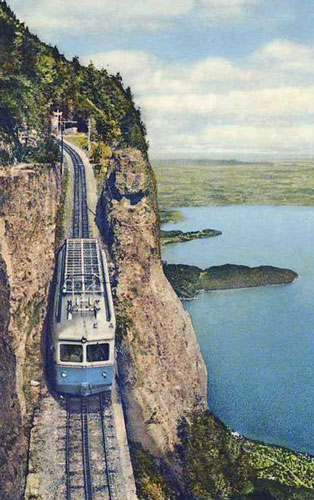
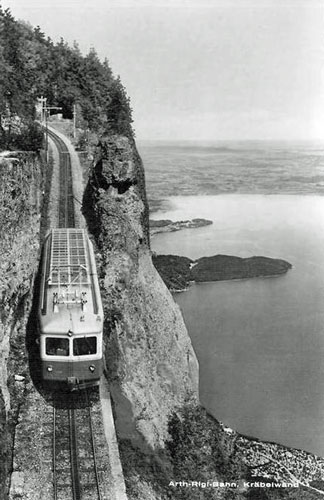
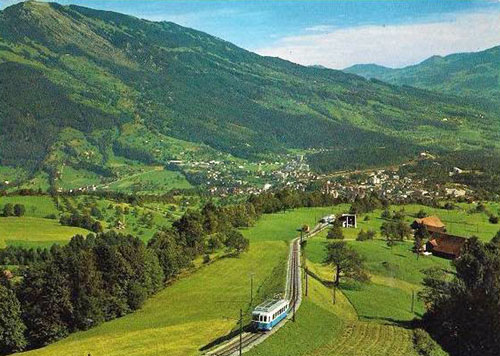
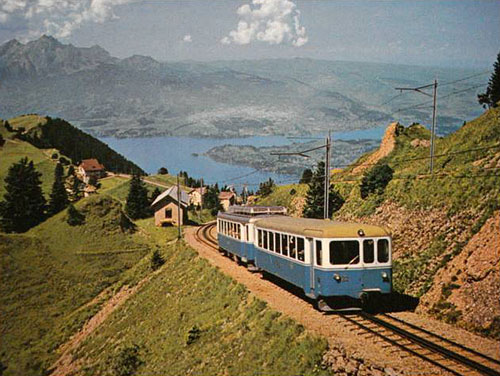
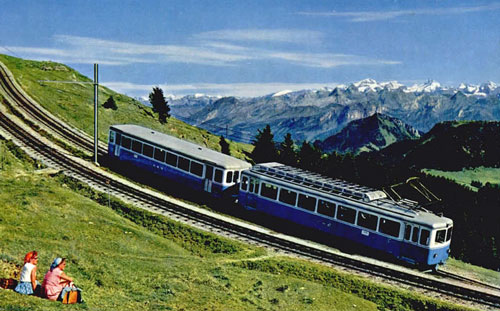
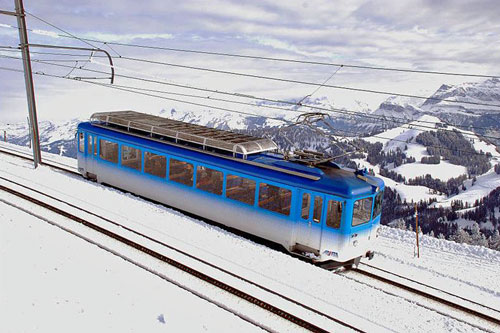
Whilst the Arth-Rigi railway
was under construction, another line on the Rigi massif was also being
built. This linked Rigi-Kaltbad, on the Vitznau-Rigi line, with Scheidegg to
the east. Unlike the previous two lines, the Rigi-Scheidegg Bahn followed
the contours near the top of the mountain, rather than climbing it, and was
not a rack railway. Also unlike the other two lines, it was built to metre
gauge rather than standard gauge, and so never made a direct connection to
the other lines. The line opened, in two stages, in 1874 and 1875.
In 1931 the Rigi-Scheidegg Railway, which had never been electrified, was
closed. This line, which includes a 70 metres (230 ft) tunnel and several
bridges, now serves as a panoramic footpath and in winter is also used for
cross country skiing.
(Ref: Wikipedia)
Postcards of the Rigi-Scheidegg Bahn
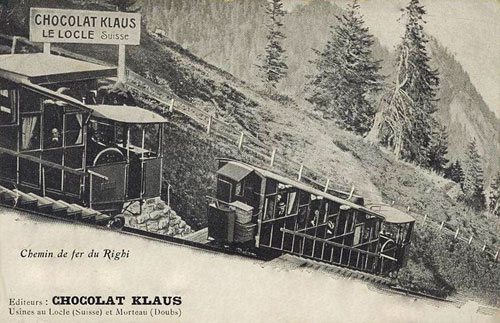
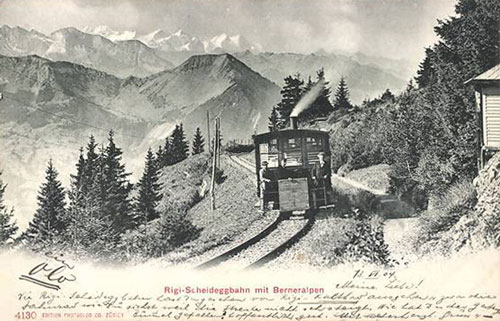
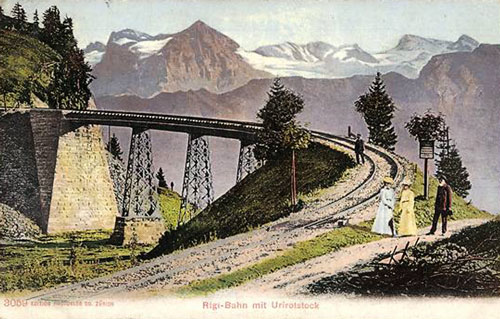
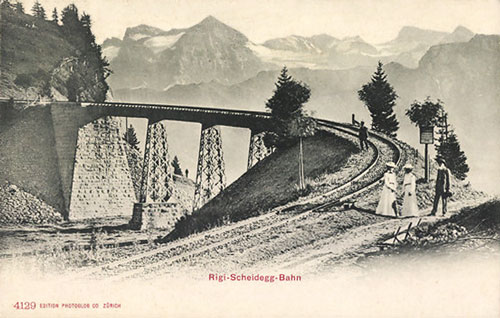
Luftseilbahn Weggis-Rigi Kaltbad
In 1967 the Swiss government
granted an operating licence for an aerial cableway to run from near the
shores of Lake Luzern to a point near the summit of Rigi. To avoid direct
competition with the Vitznau-Rigi Bahn the aerial cableway was to run from
Weggis, where connections were available with the lake steamers from Luzern,
to meet the railway at Rigi Kaltbad. The licence was granted to the Rigi
Railway Company.
The construction period was short, a mere eleven months saw the new aerial
cableway completed and the opening took place on 15 July 1968. The cable car
rises from the lakeside some 924 m (3,031 ft) to its summit and has a
journey time of just 10 minutes. A 100-metre (328.1 ft) pathway at Rigi
Kaltbad connects the mountain station of the cable car with the railway
station.
The technical installations were the work of K. Garaventa & Sons of Goldau,
and the large cabins were supplied by the Carrosseriewerke Company of
Aarburg. On the 25th anniversary of the opening of the cable car (in 1993),
the original two red passenger cabins were replaced by modern panorama
cabins.
In 1992 Arth-Rigi-Bahn (ARB) in Arth and the Rigibahn in Vitznau, formally
the Vitznau-Rigi-Bahn (VRB), and the Luftseilbahn Weggis-Rigi Kaltbad (LWRK)
to create Rigi Bahnen AG
(Ref: Wikipedia)
Postcards of the Luftseilbahn Weggis-Rigi Kaltbad
(LWRK)
